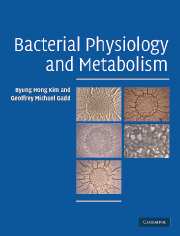Book contents
- Frontmatter
- Contents
- Preface
- 1 Introduction to bacterial physiology and metabolism
- 2 Composition and structure of prokaryotic cells
- 3 Membrane transport – nutrient uptake and protein excretion
- 4 Glycolysis
- 5 Tricarboxylic acid (TCA) cycle, electron transport and oxidative phosphorylation
- 6 Biosynthesis and microbial growth
- 7 Heterotrophic metabolism on substrates other than glucose
- 8 Anaerobic fermentation
- 9 Anaerobic respiration
- 10 Chemolithotrophy
- 11 Photosynthesis
- 12 Metabolic regulation
- 13 Energy, environment and microbial survival
- Index
- References
8 - Anaerobic fermentation
Published online by Cambridge University Press: 05 September 2012
- Frontmatter
- Contents
- Preface
- 1 Introduction to bacterial physiology and metabolism
- 2 Composition and structure of prokaryotic cells
- 3 Membrane transport – nutrient uptake and protein excretion
- 4 Glycolysis
- 5 Tricarboxylic acid (TCA) cycle, electron transport and oxidative phosphorylation
- 6 Biosynthesis and microbial growth
- 7 Heterotrophic metabolism on substrates other than glucose
- 8 Anaerobic fermentation
- 9 Anaerobic respiration
- 10 Chemolithotrophy
- 11 Photosynthesis
- 12 Metabolic regulation
- 13 Energy, environment and microbial survival
- Index
- References
Summary
Anaerobic conditions are maintained in some ecosystems where the rate of oxygen supply is lower than that of consumption. Organic compounds are removed from anaerobic ecosystems through the concerted action of fermentative and anaerobic respiratory microorganisms. In microbiology, the term ‘fermentation’ can be used to describe either microbial processes that produce useful products or a form of anaerobic microbial growth using internally supplied electron acceptors and generating ATP mainly through substrate-level phosphorylation (SLP).
Electron acceptors used in anaerobic metabolism
Fermentation and anaerobic respiration
Respiration refers to the reduction of oxygen by electrons from the electron transport chains coupled to the generation of a proton motive force through electron transport phosphorylation (ETP; Section 5.8). Under anaerobic conditions, some microorganisms grow using an ETP process with externally supplied oxidized compounds other than oxygen as the terminal electron acceptor. This type of growth is referred to as anaerobic respiration. In a fermentative process, ATP is generated through SLP with the oxidation of electron donors coupled to the reduction of electron carriers such as NAD(P)+ or flavin adenine dinucleotide (FAD). The reduced electron carriers are reoxidized reducing the metabolic intermediate.
This chapter describes the fermentation processes carried out by various anaerobic prokaryotes. In fermentation, ATP is generated not only through SLP but also by other mechanisms such as the reactions catalyzed by fumarate reductase and Na+-dependent decarboxylase, and lactate/H+ symport as described earlier (Section 5.8.6).
- Type
- Chapter
- Information
- Bacterial Physiology and Metabolism , pp. 252 - 297Publisher: Cambridge University PressPrint publication year: 2008
References
- 2
- Cited by



